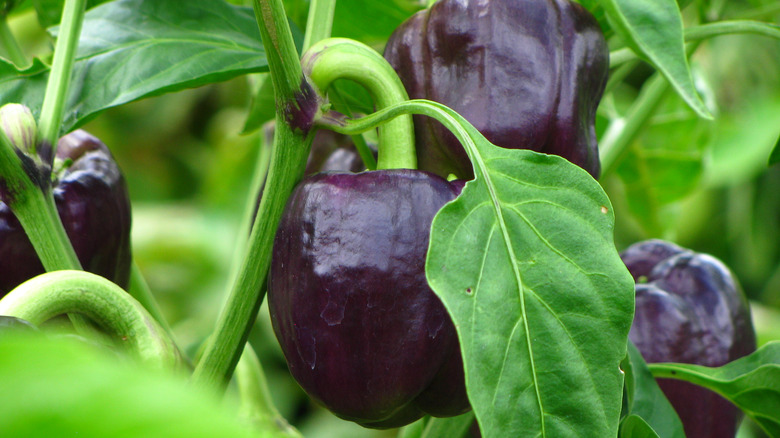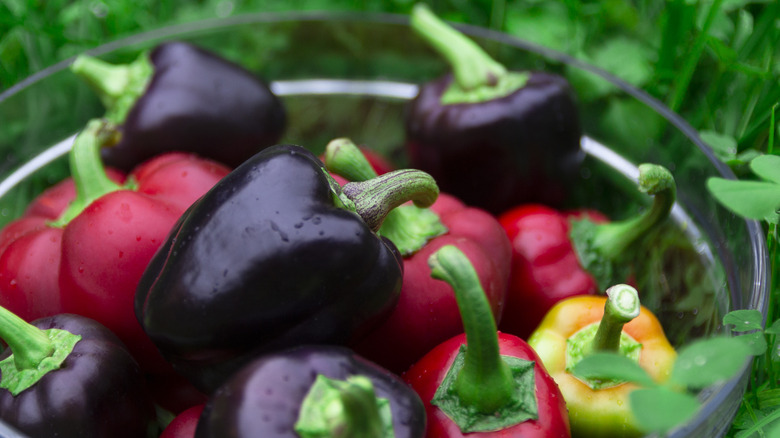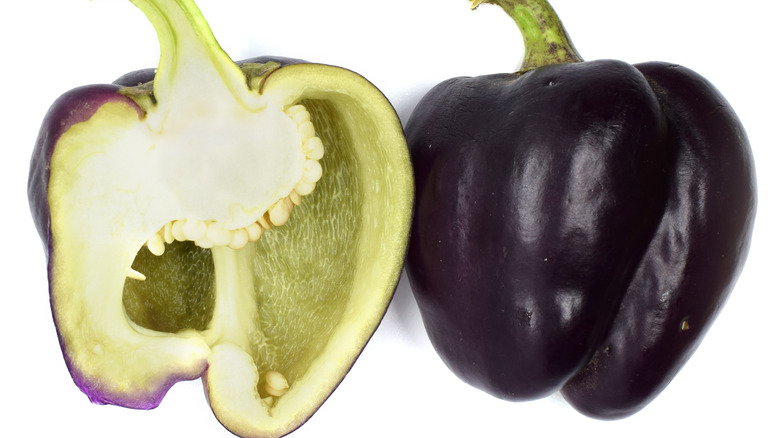Dragonfly Peppers Are The Easy Way To Elevate Your Next Salad
There are naturally black foods that have been around forever — black grapes, blackberries, black sesame seeds, and black olives, for instance. But there are also jet-blackened foods that have risen to popularity in recent years (think squid ink pasta and activated charcoal everything) that come with outrageous health claims, to both positive and negative ends. But some black foods are truly good for you, not just for decoration.
One relative newcomer to the delightful food "dark side" is the dragonfly pepper — a deep purple bell pepper. ACS Publications reports that this striking vegetable is stealing the spotlight due to its particularly high anthocyanin content, which is responsible for its dark violet pigmentation and its impressive nutritional profile.
According to Healthline, anthocyanins, which are found also in red and blue produce, are natural compounds that may boost neurological health and protect eaters from inflammation, cancer, heart disease, and type 2 diabetes.
Points for the purple pepper
Park Seed explains that the dragonfly is an F1 hybrid purple sweet bell pepper: deep purple on the outside, vibrant light green on the inside, thick-walled, and robust. Dragonfly peppers have a high water content that gives them a hearty crunch and solid construction.
All-America Selections explains that dragonfly peppers exhibit a superior color and flavor to other purple varieties, with fruits that grow well above the ground and never fade. (Still, if you leave the peppers unpicked, they'll eventually turn red.) Once harvested, the peppers keep for a long time, Park Seed adds.
If you plan to grow dragonfly peppers in your garden, sources describe them as prolific producers but caution that they're especially delicate when it comes to frost. Be sure to plant them only in warm soil with no danger of winter weather, in full sun, with well-fertilized soil for best results. They're said to be tough plants, resisting heat spells and droughts and some common pepper ailments, but Almanac notes that because they need a long growing season, you might want to seek out starter plants instead of seeds (or just find them in the produce aisle or farmer's market). So, how do you enjoy them?
Cooking with purple peppers
Gurney's recommends using dragonfly peppers for relish trays, where their boldly contrasting colors will be especially eye-catching. They would certainly spruce up any salad bowl, too.
Why not crank up the color with Food Network's recipe for purple Peruvian potato and bell pepper salad? Or beautiful bell pepper slaw? There's also The New York Times' bell pepper salad with capers and olives and Martha Stewart's roasted red pepper salad, which would look (and taste) amazing with dark dragonfly peppers mixed in.
In terms of cooked dishes, you can make an ordinary stuffed pepper recipe extraordinary or fancy up your weeknight fajita recipe. In short, use dragonfly peppers anywhere you'd use other colors of bell peppers. Purple peppers are an effective intermediary between savory, slightly bitter green peppers and the sweeter, riper colors. (They might even redeem green peppers for you if you're not exactly a fan.)


